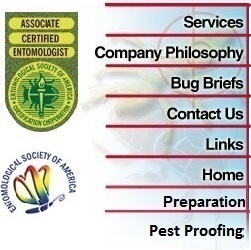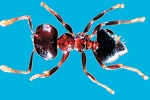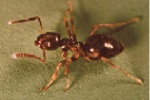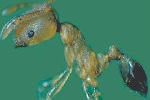
|
 Both ants and termites will swarm and look alike.  Wings, waist, & antennae can tell them apart. |
|
Fire Ants in Missouri I am constantly encountering people who say they have experienced a fire ant invasion and quite frankly that is not likely. The normal range of fire ants has a northern boundary of north Arkansas and the only areas in Missouri that experience fire ants are around the boothill of the state. There have been reports verified in this area in the past but they have all been traced to temporarily bringing them in in things like hay bails from other areas. Fire ants have a low temperature treshold of 10-15 degrees so even a moderate winter in this area would destroy the colony. If you are seeing a little red or brown ant outside on the ground, it is probably a pavement ant or some other ant. |
Carpenter Ants Many people have a misconception that Carpenter Ants eat wood like Termites but that is not the case. They are opportunistic in that they will get into wood that is damaged mostly by moisture. They are very common outside in dead parts of trees and hollowed out areas, old firewood on the ground etc. They can establish colonies inside home but again mostly in wet damged wood. It is common for them to have nests outside in trees or similar things and establish a satelite colony off the main one inside the home in less than perfect conditions. We have seen nests in shower curtain rods, coolers that they were going thru the open spout, hollow door frames etc. They forage at night during summer. They nest in wooded areas but only excavate the wood for the shelter. They are among the largest ants and I often see black field ants which nest in the ground, being confused for them. |
Treating for Ants Most will tell you just find the nest and eliminate it but that is harder than you think even with ants that travel in well defined trails. If you just treat where you see the ants you are likely to make the problem worse as they will go around the spray or split their colony becuase they feel threatened. Baits will work but most people don't have the patience to wait several days or weeks for the baits to eliminate all the ants. The approach we use is to try to find the nest and when we can't to use materials that are non-reppellent and delayed in nature, that is they do not repel the ants and the ants will readily cross the chemicals. By doing that, the ants pick up the chemicals on their bodies and take that chemical back to the nest and because they are social insects, they feed one another and groom one another and dispurse the chemical thru the entire colony, thus eliminating them. These act similar to baits but they don't have to eat them, only walk across them. Read Straight Talk |
|
We are as savvy as an old dog but as eager as a puppy to serve you ! |



